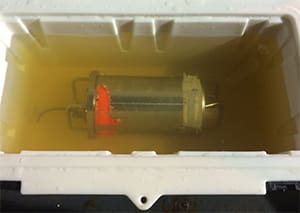Bridge audio captured by El Faro’s voyage data recorder (VDR), made available by the National Transportation Safety Board in December provides a harrowing account of the ship’s last 26 hours at sea.
The transcript answers some lingering questions about the voyage but also raises new ones. For instance, it is now known that Capt. Michael Davidson ordered crew to abandon ship about 10 minutes before the VDR stopped recording, but it is not known if anyone made it off the vessel.
Crew described flooding from an open scuttle on the second deck, but there is also mention in the transcript of a ruptured fire main that might have worsened the flooding. The crew discussed the ship’s 15-degree starboard list and potential impacts on engine oil levels, but it’s still not clear what caused the engine to fail.
Capt. Joseph Murphy, who retired in December from Massachusetts Maritime Academy, remains convinced the drifting ship capsized very suddenly while taking a pounding from Hurricane Joaquin. But based on the transcript, he sees no single catastrophic failure that doomed the 791-foot El Faro. Rather, he believes the accident was a “classic cascade event.”
“One thing goes, then the next thing goes, then the next thing goes,” Murphy said in a recent interview. “If at any point along the way they were able to break that chain, the ship might have survived.”
El Faro was sailing from Jacksonville, Fla., to San Juan, Puerto Rico, with cargo containers, vehicles and trailers when it sank on Oct. 1, 2015, roughly 36 nautical miles northeast of Crooked Island in the Bahamas. At that point, the ship was 22 miles north-northwest of Hurricane Joaquin’s center. There were 28 crew and five Polish contractors on board and all hands perished in the accident.
El Faro’s parent company, TOTE Maritime, issued a statement after the VDR transcript was released describing the ship’s final moments as “heartbreaking.” The company also said it was clear its crew acted heroically.
“(We) encourage people not to rush to judgment because the transcript is raw data and the NTSB and Coast Guard are still conducting an official investigation, which we are fully supportive of and cooperating in. TOTE is hopeful the VDR information will help with the goal to learn everything possible about the loss of our crew and vessel,” the statement said, adding that TOTE would not discuss the issue further.
The first mention of flooding occurred at 0543 on Oct. 1 with news that the No. 3 cargo hold was taking on water. The situation went from bad to worse when the ship’s plant failed at 0613.
Capt. Davidson initially believed the engine would come back online relatively soon. But by 0654 it was still down, winds were battering the ship and “a significant amount” of flooding was reported in the No. 3 hold.
“They having trouble getting it back online?” the second mate asked at 0657.
“Yeah, because of the list,” Davidson responded.
Davidson sounded the general alarm at 0727 and a minute later he asked over radio that all crew get immersion suits ready. The second mate on the bridge spotted containers in the water at 0729. Seven seconds later, Davidson ordered crew to abandon ship.
The VDR recording ended at 0739, with Davidson and a helmsman still on the bridge fighting for their lives.

